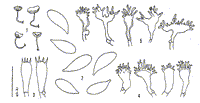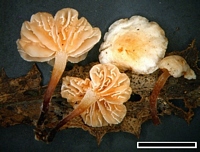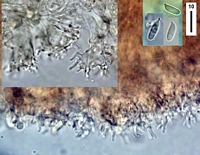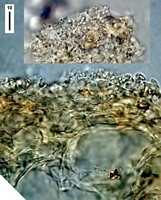|
 Marasmius pusio Marasmius pusio
BiostatusPresent in region - Indigenous. Non endemic
Images (click to enlarge)
Caption: Fig. 16 (1-5). Marasmius pusio Berk. & M. A. Curtis (ZT 68-683).- 1. Basidiomes.- 2.
Basidiospores.- 3. Basidia.- 4. Cheilocystidia.- 5. Pileipellis. | 
Caption: scale=5mm
Owner: J.A. Cooper | 
Caption: cheilocystidia and spores
Owner: J.A. Cooper | 
Caption: upper: top down view of cap cells. Lower section through cap showing subepidermal spherical cells
Owner: J.A. Cooper | |
Article: Desjardin, D.E.; Horak, E. (1997). Marasmius and Gloiocephala in the South Pacific Region: Papua New Guinea, New Caledonia, and New Zealand taxa. Bibliotheca Mycologica 168: 152 p.
Description: Pileus 4-10 mm diam, hemispherical to convex when young, expanding with age to plano-convex or
plane with depressed to subumbilicate disc, papilla absent; margin decurved to uplifted, non-striate;
surface dull, dry, minutely wrinkled especially over the disc, pruinose; pale ochre-brown, apricot or
orangish brown. Texture membranaceous; context thin, buff.- La mellae broadly adnate, subdistant
(10-16) with 2-3 series of lamellulae, narrow to moderately broad (up to 1 mm); cream to pale
apricot; edges fimbriate, concolorous or pale brown.- Stipe 7-18 x 0.5-0.8 mm, central, equal or
gradually tapering towards the base, often curved, minutely pruinose, tough, non-insititious,
with short white to buff fibrils or rhizomorphs at the base; apex cream to pale apricot, pale
orangish brown elsewhere.- Odor and taste not distinctive.
Basidiospores 8.0-10.5 x 3.5-4.5 µm, narrowly ellipsoid or subfusoid, sometimes curved in
profile, smooth, thin-walled, hyaline, inamyloid. - Basidia 18-22 x 7-8 µm, clavate, 4-spored,
clamped.- Basidioles 20-30 x 5-8 µm, fusoid, hyaline, often incrusted with resinous matter.-
Cheilocystidia of Siccus-type cells; main body 10-20 x 5-9 µm, subclavate to clavate or
irregular in outline, sometimes lobed, thin-walled to moderately thick-walled, hyaline; apical
setulae 1-6 x 1-2 µm, irregular in outline, often forked and nodulose, hyaline to pale yellowish
brown.- Pleurocystidia absent.- Pileipellis hymeniform, not mottled, composed of Siccus-type
cells; main body 10-20 x 4-9 µm, clavate or irregular in outline, often lobed, thin-walled to
moderately thick-walled, hyaline, weakly dextrinoid; apical setulae 1-6 x 1-2 µm, irregular in
outline, often forked, yellowish brown. - Tramal tissues non-gelatinous, inamyloid.- Stipe
tissue monomitic, weakly dextrinoid.- Caulocystidia absent or of poorly developed Siccus-type
cells, similar to the cheilocystidia, hyaline.- Clamp connections present.
Habitat: Habit, habitat and distribution.- Solitary, on mossy bark of Daciydium dacrydioides
(Podocarpaceae; holotype) or on rotting leaves and culms of Carex sp. New Zealand, North
America, South America.
Notes: Salient features of M. pusio include: a small, non-striate, apricot to orangish brown pileus;
subdistant, cream-colored lamellae with pallid or brownish edges; a short, pruinose, non-insititious,
orangish brown stipe; relatively small basidiospores; no pleurocystidia; cheilocystidia and pileipellis
cells with short setulae; Siccus-type caulocystidia; and growth on Dacrydium and Carex.
Marasmius pusio, first described from material collected in South Carolina; USA (Holotype, K!;
Isotype, FH!), has been reported from southeastern north America and throughout South America.
A number of varieties have been described differing in subtle differences in basidiospore width,
stipe pigmentation, and substrate (see Singer, 1976). The New Zealand material appears closest to
pusio var. graminivorus Sing. from Argentina (Holotype, F!), and M. armeniacus Gilliam from
North America (which we consider a variety of M. pusio; Holotype, MICH!), both with orange
pigments in the stipe and habit on monocotyledonous leaves. Until further material of all described
varieties becomes available for analysis of variation, we prefer not to assign the New Zealand taxon
to a particular variety.
|